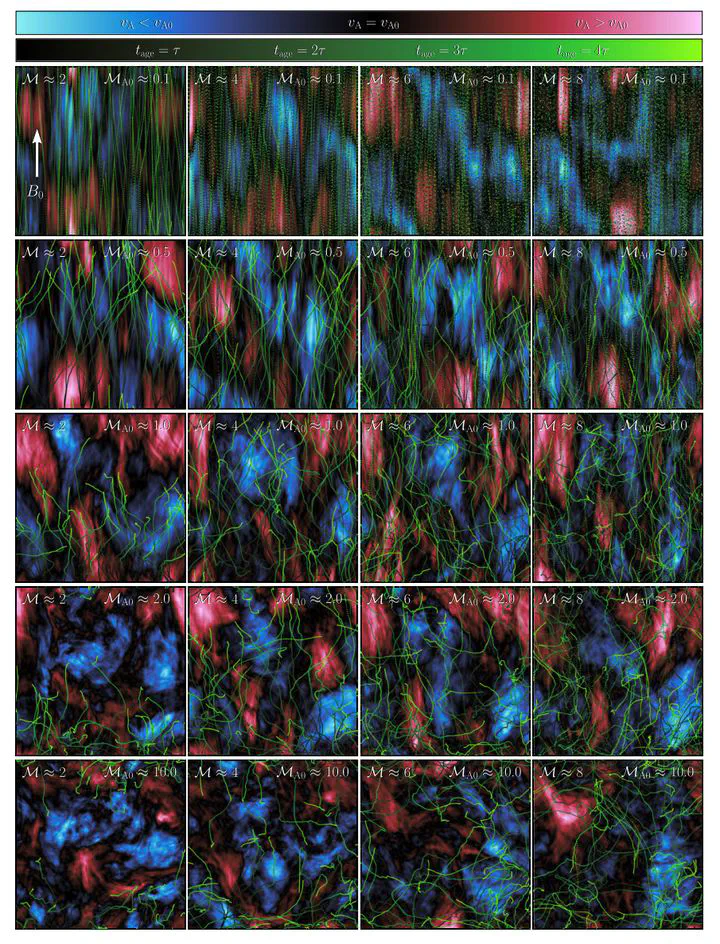Turbulent diffusion of streaming cosmic rays in compressible, partially ionized plasma

Abstract
Cosmic rays (CRs) are a dynamically important component of the interstellar medium (ISM) of galaxies. The ∼GeV CRs that carry most CR energy and pressure are likely confined by self-generated turbulence, leading them to stream along magnetic field lines at the ion Alfvén speed. However, the consequences of self-confinement for CR propagation on galaxy scales remain highly uncertain. In this paper, we use a large ensemble of magnetohydrodynamical turbulence simulations to quantify how the basic parameters describing ISM turbulence – the sonic Mach number, (plasma compressibility), Alfvén Mach number, (strength of the large-scale field with respect to the turbulence), and ionization fraction by mass, χ – affect the transport of streaming CRs. We show that the large-scale transport of CRs whose small-scale motion consists of streaming along field lines is well described as a combination of streaming along the mean field and superdiffusion both along (parallel to) and across (perpendicular to) it; drives the level of anisotropy between parallel and perpendicular diffusion and χ modulates the magnitude of the diffusion coefficients, while in our choice of units, is unimportant except in the sub-Alfvénic ( ) regime. Our finding that superdiffusion is ubiquitous potentially explains the apparent discrepancy between CR diffusion coefficients inferred from measurements close to individual sources compared to those measured on larger, Galactic scales. Finally, we present empirical fits for the diffusion coefficients as a function of plasma parameters that may be used as subgrid recipes for global ISM, galaxy, or cosmological simulations.
Type
Publication
Monthly Notices of the Royal Astronomical Society 519 (1), 1503-1525
ML Sampson, JR Beattie, MR Krumholz, RM Crocker, C Federrath, A Seta (2023)
Cosmic rays (CRs) are a dynamically important component of the interstellar medium (ISM) of galaxies. The ∼GeV CRs that carry most CR energy and pressure are likely confined by self-generated turbulence, leading them to stream along magnetic field lines at the ion Alfvén speed. However, the consequences of self-confinement for CR propagation on galaxy scales remain highly uncertain. In this paper, we use a large ensemble of magnetohydrodynamical turbulence simulations to quantify how the basic parameters describing ISM turbulence – the sonic Mach number,
(plasma compressibility), Alfvén Mach number,
(strength of the large-scale field with respect to the turbulence), and ionization fraction by mass, χ – affect the transport of streaming CRs. We show that the large-scale transport of CRs whose small-scale motion consists of streaming along field lines is well described as a combination of streaming along the mean field and superdiffusion both along (parallel to) and across (perpendicular to) it;
drives the level of anisotropy between parallel and perpendicular diffusion and χ modulates the magnitude of the diffusion coefficients, while in our choice of units,
is unimportant except in the sub-Alfvénic (
) regime. Our finding that superdiffusion is ubiquitous potentially explains the apparent discrepancy between CR diffusion coefficients inferred from measurements close to individual sources compared to those measured on larger, Galactic scales. Finally, we present empirical fits for the diffusion coefficients as a function of plasma parameters that may be used as subgrid recipes for global ISM, galaxy, or cosmological simulations.